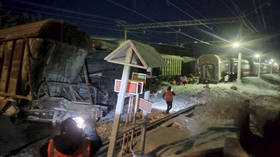Chemical weapons: Easy to make and disperse, impossible to get rid of
Anyone with a few years of training in chemistry and access to some freely available raw materials could easily produce chemical weapons like sarin gas, chemical weapons expert and Rice University professor James Tour told RT.
Although it is unlikely that “somebody on the street” could do it, Tour says that by recruiting a chemist with just about a master’s level of training, Syrian rebels could easily pull off a deadly attack.
And if the political solution fails and the US proceeds with the planned surgical strikes on Syria’s military facilities including depots holding chemical weapons, Tour says it will only expose those in the location to their debilitating effects, which cause the afflicted to writhe in pain and lose all motor control, akin to an insect sprayed with insecticide.
RT:It’s suspected that sarin was used in that chemical attack in Syria. What is it and is it easily produced?
James Tour: It’s easily produced. Sarin is a nerve gas and it’s different than a typical chemical weapon being a nerve agent. It’s a lot more toxic.
RT:If you are a victim of a sarin attack, are you likely to die or can you actually survive an attack of this kind?
JT: People can survive, but the likelihood of death is quite high with sarin. Being a nerve gas, it’s much akin to when a person sprays insecticide on an insect and the insect starts writhing in pain for a couple of minutes and then dies. It’s very much the same with a nerve agent. It works the same way that an insecticide works on an insect, it’s just that their enzymatic cavity is a little bit different than the size of our enzymatic cavity and you design the molecule a little bit differently and so it would not affect an insect, but for people, what it does is they lose all motor control and they no longer can even control their breathing and so they just start writhing like an insect would.
RT:You say it’s easily produced. If, for example, stockpiles of sarin were removed from Syria, it can easily be made again, not just by authorities but by anybody?
JT: Anybody with access to some raw materials. The raw materials are not gotten at a grocery store, but they can come in very easily. One can buy on the chemical market items that are one step away from sarin, easily two steps away. So a chemist with about a Master’s level of training can produce sarin quite easily.

RT:So the rebels in Syria could easily have used chemicals themselves in an attack of that kind?
JT: They could if they had recruited some chemists with a few years of training in chemicals. It’s not something somebody on the street could pick up in a few weeks. They need a little more training than that, and they need proper facilities to make it. They need a chemical hood, but it certainly could be made.
RT:Presumably there are other sorts of chemical weapons available?
JT: Yes, there are many different types of chemical weapons available. Some of them easier to make than sarin – not quite as effective as sarin is but easily made and easily brought in, easily transported.
RT:What about this idea of bombing areas or depots that are suspected of holding chemical weapons? That sounds quite reckless. Is that the way to go about removing that sort of threat?
JT: Generally what will happen is if exposed to bombings it can spread the chemicals, so all those in the region would be at risk once the chemicals are exploded in that way. There are other ways needed to remove these sorts of weapons, and that’s generally by a hydrolysis. In other words, adding to a large amount of water, or water with sodium hydroxide.
RT:You conducted an experiment to prove making chemical weapons is very easy to do. If that’s the case, why haven’t we seen more terrorist attacks using more chemical weapons?
JT: One of the reasons is probably because of natural
selection. Those that try to make it, if they don’t know what
they’re doing, they’re going to die in making it. So it’s risky
business if you don’t know what you’re doing.
If you know what you’re doing, if you have about a Master’s level
of training – we did several tests to assess what level of
training one would need – one could pull this off really quite
easily. Access to the chemicals is easy and then dispersion is
easy.
Why there have been not as many attacks with chemical weapons, I’m not sure. But there are actually dozens of documented chemical attacks, I know, in the United States. They don’t receive a lot of attention, but there are documented attacks.
RT:Finally, we can’t rid the world of chemical weapons, can we?
JT: No, that’s absolutely impossible. They’re too easy to
make, and they are frightening if made.
The statements, views and opinions expressed in this column are solely those of the author and do not necessarily represent those of RT.












